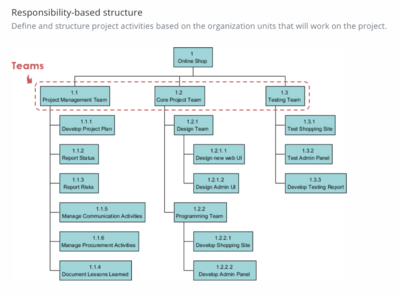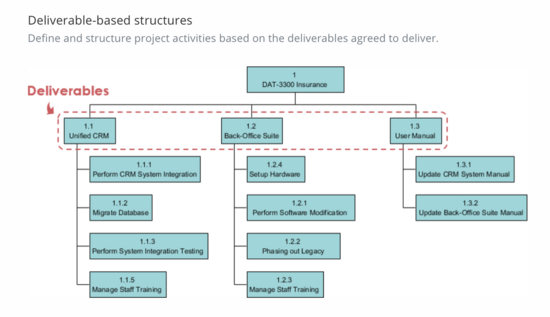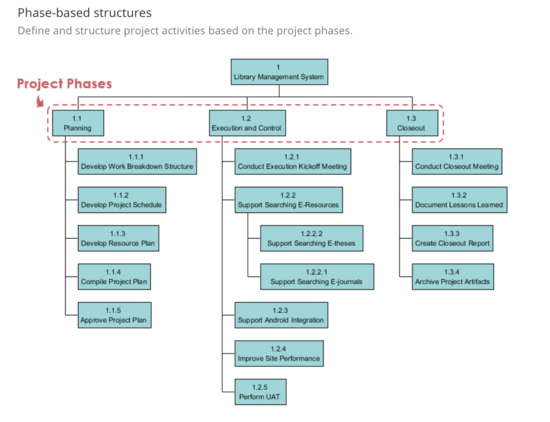Work breakdown structure for project management
Contents |
Abstract
Work breakdown structure, as the wording suggests, refers to the tool utilised to break larger work into smaller tasks. This is a common productivity technique related to project management, seeking to make the work and complexity af the task more manageable and approachable. It is defined by The Project Management Institute (PMI) Project Management Book of Knowledge (PMBOK) as a “deliverable oriented hierarchical decomposition of the work to be executed by the project team.”. The work breakdown structure is seen as one of the most vital tools to utilise the work breakdown technique as well as project management document. It integrates both scope, cost and schedule baseline for the project, ensuring that these are in line with the project plan. [1] The work breakdowns structure was originally used in project management, but is also becoming increasingly popular to utilise in program, portfolio and enterprise management. The workbreak down can be structured based on different project characteristics such as deliverables, phases and responsibilities, and common for these are that the final product is decomposed hierarchically but all together represents 100% of the work to be carried out.
Big Idea
The Work Breakdown Structure (WBS) describes an effective technique used in decomposing a project (or even a program, portfolio or enterprise) down into hierarchical deliverable elements. Each of these elements should correspond to a specific outcome necessary to be accomplished in order for the project to be complete. By virtue of schematically presenting all the project objectives and their relation between one another in appropriate format and level of detail, a WBS is in particular great in providing a clear overview of the project scope. Furthermore, a well-designed and properly maintained WBS displaying the tasks and dependencies to the project associates or workers carrying out the work, makes it a valuable tool applicable to projects of any size and complexity. [2]
Use of the Work Breakdown structure
The work breakdown structure serves to cater many project management disciplines. Initially, it serves as a planning tool to help the project team plan, define and organize scope with deliverables. The Work breakdown own structure is usually also used as the primary source of schedule and cost estimate activities. Moreover, it is used as a description of all the work related to a project and a tool for monitoring and controlling these, which serves as its biggest contribution to project managers.
The level of decomposition varies in between projects, but it usually depends on the degree of control needed to properly manage the work that has to be achieved.
Each one of the deliverables of the WBS corresponds to a specific outcome that must be accomplished to complete the project. Every descending level of the structure includes the deliverables that must be carried out in order to fulfil the outcome located in the level right above. It is important to note that the deliverables must be outcomes, not actions. That is because outcomes are final products or results that can be precisely predicted, whereas the actions and procedures followed to obtain them cannot always be anticipated. Project activities are not listed, as these are components of the project schedule, not the WBS.[2]
100% Rule
A critical rule associated with all levels of a work breakdown structure, regardless of its type, is the 100% Rule. The aim of this rule is to achieve the effective creation of the WBS and to assess its disintegration. The exact definition of the 100% rule “The next decomposition of a WBS element (“child” level) must represent 100 percent of the work applicable to the next higher (“parent”) element.
The WBS is a process required to ensure the project includes all the work required, and only the work required, to complete the project successfully.[2] This is achieved thanks to the application of the 100% Rule. The 100% Rule is a principle which states that the WBS includes 100% of the project’s scope and 100% of the deliverables that form it. The rule also applies to each one of the levels within the hierarchy. All the deliverables that form a descending level must equal to 100% of the work needed to complete the outcome stated in the previous level. The lowest levels should roll up to the higher levels so that nothing is left out and no extra work is performed.[1]
Application
The levels of a work break down structure
A work breakdown structure is usually developed in a structured way imitating the shape of an inverted tree. It is organized based on objectives, looking like an organizational chart, that can help the project team and lead in visualizing the entire project with its main components. The hierarchy of the work in the project is broke down vertically, moving from the goal of the project in the top to the tasks and their subtasks on the bottom. When estimating the project schedule and deadlines, the decomposition framework provides a good level of confidence, as it shows all the work to be accomplished – or the 100% of the work in the project.
Level 1
Breaking the structure into levels the first level can be said to hold the project’s ultimate goal. This level comprises the full scope of the work which will be necessary to produce and deliver a product or project. It includes all direct and indirect work. It is always a single WBS element. It can be composed of a name and a WBS identifier, to help differentiate it from other WBSs in a program or portfolio of projects. The numbering of level 1 affects the numbering down through the tree accordingly.
Level 2
The second level contains the project objectives or the outcomes of the project delivery. The second level is the first level of decomposition and is a high-level breakdown of the scope into key areas. In producing a product this will hold the basic components of the product including the project management and integration of parts. Include an annotated Example of a WBS This WBS example is based on an organization building and delivering a product to a customer’s specifications. The levels hold together the 100% of the entire workload present in the project.
Level 3
The third level decomposes the key areas of level 2 into its essential parts. This contains the project deliverables and starts to target specific and tangible outputs of the project of production phase. In creating a product this would include all the output parts need to be made in order to make the product.
Level 4
Based on the projects scope and level of complexity, it can for some projects be relevant to include a fourth level. The fourth level describes the activities and contains the specific tasks to be carried out. Depending on the project complexness this level might be holding a lot of tasks which, in the same manner each represents 100% of each exclusive area from level 3. An example of this can be product tests related to the quality control deliverable.
In general it is possible to distingue between three types of work breakdown structures:
Deliverable-based work break down structure
Deliverable-based work breakdown structures is the most common approach, and often the preferred way to initiate the phase of defining how to achieve succes in a project or program.
The key idea behind deliverable-based structure is greatly related to the overall approach of decomposing extremely complex tasks and projects into less complicated smaller fragments, the difference for the approach compared to the other two outlined methods (outlined below) is that with deliverable-based structure you focus on breaking the task down into smaller agreed deliverables.
In order to explain the method in full, it is important to define what a deliverable is. A deliverable can be a temporary mean or tool needed to fulfill a project or final element produced in order to successfully complete the project. For example, an IT contractor might develop prototypes and budget estimates as so-called interim deliverables for the customer to evaluate, however these are not the deliverables that would be a part of the final solution and serve as a satisfying project-delivery. The final deliverables would be relevant platforms and applications performing the tasks desired by the user.
Operating a deliverable-based approach means one’s breakdown structures are formulated as tangible components such as physical objects that can be produced or gathered or delivered, etc. In the theory the methodology is thus often referred to as the approach where you phrase your components in nouns.
When creating a deliverable based WBS several criteria can be used for developing the plan in order to meet specific requirements from the project. For example, a craftsman who is building a house might decide to break down the project into elements reflecting rooms in the house, levels above the ground, building elements such as concrete or wood, etc. The deliverables for this should then clearly be stated as: “cast concrete for foundation”, “windows in place” or “roof rafters erected”.
Phase-based work break down structure
Phase based work break down structure is opposed to the deliverable based work breakdown structure not necessarily bound to specific deliverables to be in place in order to complete the subtask. The phase-based work break down structure will more likely have some ....
Stage gate model .....
3) Responsibility based structure

Creating a Work breakdown structure
When creating a work break down structure.....
Know your project scope.....
Identify Key Deliverables.....
Determine Work Packages.....
Use the Right Format.....
Keeping the WBS continuously relevant
During the initiating and planning phases, the primary role of the WBS is often to collecting and documenting information regarding the project. This serves as a mutual point of clarification for the team members. It describes, often in great detail, the project scope and their boundaries as well as the deliverables and outcomes of the project. During Executing and Monitoring and Controlling phases, the WBS takes a more active role as opposed to the passive role in the planning phases. Here it takes on the role of project decision support and is used a source of reference for control and measurement of the project progress. This is where the WBS comes to life as a valuable tool for the project manager, as well as a guideline and common ground for all team members working on the project. Cite error: Closing </ref> missing for <ref> tag
Cite error:
<ref> tags exist, but no <references/> tag was found

